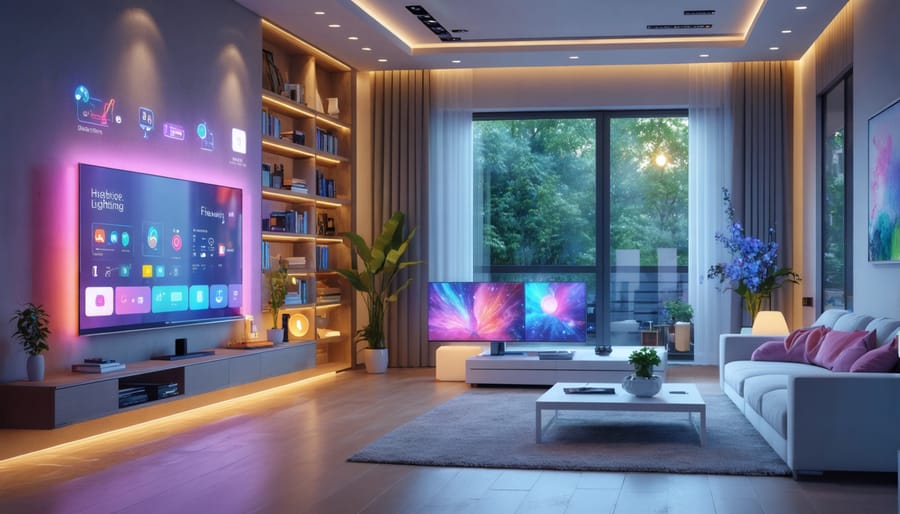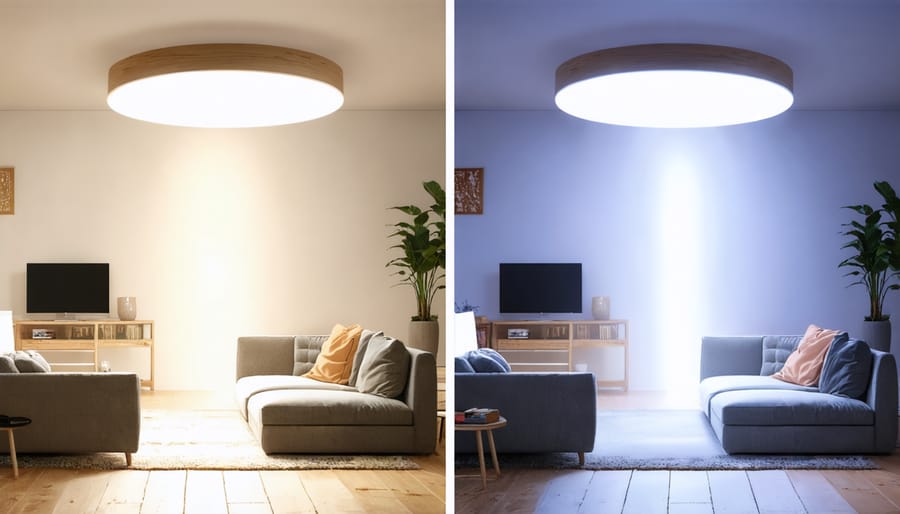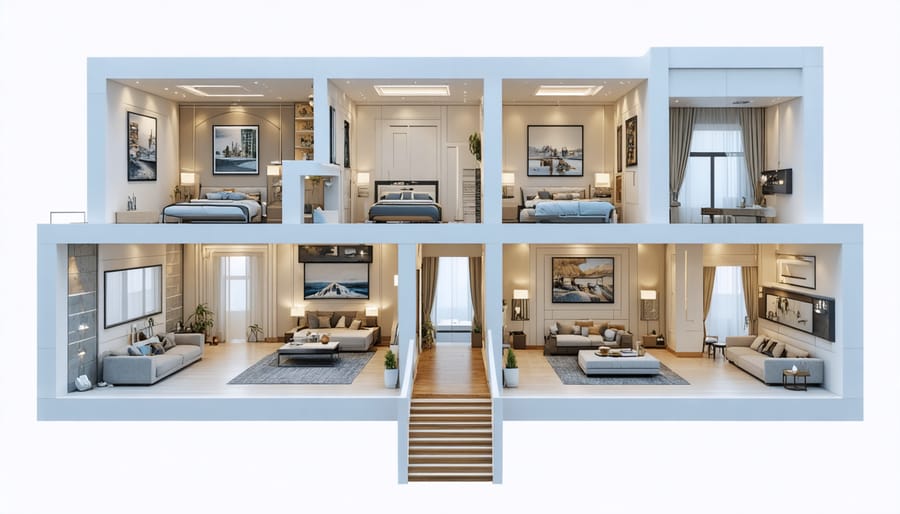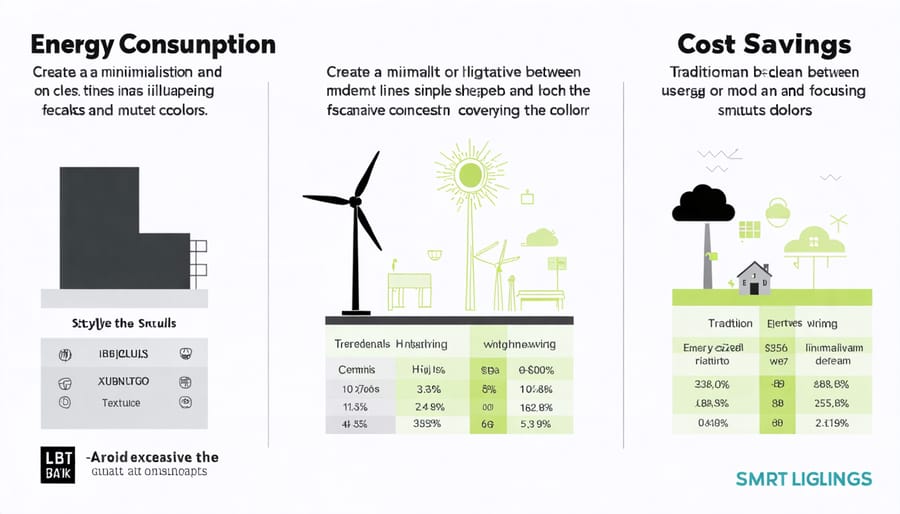
Smart Lighting That Actually Makes Your Home More Livable
Transform your living space instantly with smart lighting that adapts to your daily routines, enhances security, and slashes energy costs. Modern LED systems paired with smart controls revolutionize how we interact with our homes, making integrating smart devices simpler than ever before.
Picture walking into rooms that automatically illuminate to your preferred brightness, adjusting throughout the day to match natural light patterns. Create personalized scenes for movie nights, dinner parties, or working from home with a simple voice command or tap on your smartphone. Smart lighting doesn’t just brighten spaces—it transforms them into responsive environments that enhance comfort, productivity, and mood.
Beyond convenience, these systems offer practical benefits like automated schedules that simulate occupancy while you’re away, motion-activated pathway lighting for safety, and detailed energy consumption monitoring that helps reduce utility bills. Whether you’re retrofitting an existing home or planning a new installation, smart lighting solutions provide the perfect blend of functionality and innovation for modern living.

Beyond Basic Bulbs: Core Smart Lighting Features
Voice and App Control
Smart lighting solutions offer unprecedented control through voice commands and smartphone apps, making it easier than ever to manage your home’s lighting. Popular voice assistants like Amazon Alexa, Google Assistant, and Apple’s Siri can turn lights on and off, adjust brightness, and even change colors with simple voice commands. “Hey Google, dim the living room lights to 50%” is all it takes to create the perfect ambiance.
Mobile apps provide even more detailed control options. Most smart lighting systems come with dedicated apps that let you create custom schedules, set up automated routines, and control individual bulbs or groups of lights from anywhere with an internet connection. You can turn lights on before arriving home, simulate occupancy while you’re away, or adjust settings remotely when you’ve forgotten to turn something off.
Many apps also offer advanced features like scene creation, where you can save specific lighting configurations for different activities like movie watching, dinner parties, or reading. Some systems even integrate with other smart home devices, allowing your lights to respond automatically to motion sensors, doorbell cameras, or smart thermostats.
Scheduling and Automation
One of the most powerful features of smart lighting is its ability to automate your daily routines. Instead of manually adjusting lights throughout the day, you can program your lighting system to follow your schedule automatically. Create morning routines where lights gradually brighten to help you wake up naturally, or set evening schedules that dim lights as bedtime approaches.
For workdays, program lights to turn on when you return home or set up vacation modes that simulate occupancy while you’re away. Special occasions become even more memorable with pre-programmed lighting scenes – imagine your lights automatically creating the perfect ambiance for movie nights, dinner parties, or holiday celebrations.
Many smart lighting systems also offer motion sensors and daylight detection, automatically adjusting brightness based on natural light levels or room occupancy. This not only enhances convenience but also helps reduce energy consumption. You can even sync your lights with other smart home devices, creating sophisticated automations like lights that respond to your home security system or entertainment setup.
For extra convenience, most systems allow you to modify schedules through smartphone apps or voice commands, giving you complete control even when your routines change.
Color Temperature and Mood Settings
Color temperature dramatically influences how we feel and function in a space. Warm whites (2700-3000K) create a cozy, relaxing atmosphere perfect for living rooms and bedrooms, helping you unwind after a long day. Cool whites (4000-5000K) promote alertness and productivity, making them ideal for home offices and kitchens.
Smart lighting solutions let you adjust both color temperature and intensity throughout the day. Start your morning with energizing bright, cool light, transition to neutral white during work hours, and wind down with soft, warm ambiance in the evening. Many systems also offer vibrant color options to set the perfect mood for entertaining or create themed environments for special occasions.
The ability to save preferred settings as “scenes” means you can instantly transform your space from a productive workspace to a cozy entertainment area with just one tap.

Room-by-Room Smart Lighting Solutions
Living Room Lighting Zones
Transform your living room into a versatile space by establishing distinct lighting zones that cater to different activities. Start by identifying key areas: the main seating arrangement, reading nooks, entertainment center, and any artwork or architectural features you want to highlight.
For the main seating area, combine overhead lighting with table lamps to create a layered effect. Install dimmable smart bulbs that can adjust from bright illumination for social gatherings to softer lighting for movie nights. Place floor lamps near reading chairs with targeted brightness for comfortable reading without disturbing others watching TV.
Consider accent lighting to highlight artwork or architectural features using smart LED strips or small spotlights. For entertainment areas, integrate bias lighting behind the TV to reduce eye strain and create ambiance. Use color-changing bulbs to set different moods – warm whites for relaxation, cooler tones for productivity, and vibrant colors for parties.
Create preset scenes through your smart home app for different activities: “Movie Night,” “Reading Time,” or “Party Mode.” This allows you to switch between lighting configurations with a single tap or voice command.
Kitchen Task Lighting
In the heart of your home, effective kitchen lighting solutions are essential for both functionality and ambiance. Smart under-cabinet LED strips can automatically illuminate your workspace when you’re chopping vegetables or reading recipes. Motion sensors ensure lights activate precisely when you need them, while dimming capabilities help create the perfect atmosphere for casual dining.
Install smart pendant lights above your kitchen island that can shift from bright task lighting during meal prep to warm, ambient lighting for entertaining. Voice-controlled smart bulbs let you adjust brightness and color temperature hands-free – particularly helpful when your hands are messy from cooking.
Consider programming lighting scenes that coordinate multiple fixtures: “Cooking Mode” for maximum visibility, “Dining Mode” for a softer ambiance, or “Night Mode” for gentle pathway lighting. Many smart systems also offer scheduling features, so your kitchen lights can automatically adjust throughout the day, matching natural light patterns and your daily routine.
For energy efficiency, presence detection can turn lights off automatically when the kitchen is empty, while integration with other smart home devices enables sophisticated automation scenarios.
Bedroom Comfort Lighting
Smart bedroom lighting plays a crucial role in helping you transform your sleep routine and create the perfect environment for rest. Modern smart bulbs and light strips offer color-changing capabilities that align with your natural circadian rhythm, gradually dimming in the evening to promote melatonin production and slowly brightening in the morning to wake you naturally.
Consider installing warm-white LED strips under your bed frame for subtle nighttime illumination, or mount color-changing bulbs in bedside lamps that can shift from energizing daylight tones to sleep-friendly amber hues. Many smart lighting systems also include preset scenes for reading, relaxation, and morning routines.
Popular features include scheduled dimming sequences, motion-activated night lights, and voice control integration that lets you adjust your lights without leaving the comfort of your bed. For the best results, combine these lighting solutions with blackout curtains or smart shades to create a truly sleep-optimized space that responds to your daily patterns and preferences.
Bathroom and Hallway Safety
Bathrooms and hallways present unique lighting challenges, especially during nighttime navigation. Motion-activated lighting offers a perfect solution, automatically illuminating your path when movement is detected. Install smart LED strips along baseboards or under vanity cabinets to create subtle guidance lighting that won’t disturb sleeping family members.
For bathrooms, consider adding moisture-resistant smart bulbs that can be programmed to provide bright light during morning routines and gentle, warm illumination for nighttime visits. Motion sensors can be strategically placed to trigger lights at 10-20% brightness during late hours, ensuring safety without the shock of full brightness.
In hallways, smart lighting can create a welcoming path that automatically dims behind you as you move through the space, saving energy while maintaining visibility where needed. Many systems allow you to set schedules that adjust brightness based on time of day, ensuring optimal illumination during peak traffic hours and subtle guidance lighting overnight.
These automated solutions not only enhance safety but also contribute to energy efficiency by ensuring lights are only active when needed.
Installation and Setup Tips
DIY vs Professional Installation
Installing smart lighting can be a DIY project or a job for professionals, depending on your comfort level with technology and electrical work. For basic plug-and-play solutions like smart bulbs and plug-in fixtures, most homeowners can handle the installation themselves. These devices typically require minimal setup beyond screwing in bulbs and using a smartphone app for configuration.
However, when dealing with hardwired installations or whole-home seamless lighting integration, it’s often best to hire a professional electrician. This is especially true for projects involving new wiring, switch replacements, or complex automation systems that require careful integration with other smart home components.
Consider calling a professional if:
– Your home has older electrical wiring
– You’re installing recessed lighting or new fixtures
– You’re setting up a whole-home automation system
– You need to modify existing electrical work
– You’re uncomfortable working with electrical systems
DIY installation is suitable when:
– Installing smart bulbs in existing fixtures
– Setting up plug-in smart switches or dimmers
– Adding portable smart lamps or light strips
– Configuring basic app controls and schedules
– Creating simple automation routines
Remember, while DIY can save money, improper electrical work can be dangerous and may void your home insurance. When in doubt, invest in professional installation to ensure safety and optimal performance.
Common Setup Challenges
While smart lighting can transform your home, you might encounter some common setup challenges along the way. Don’t worry – most issues have straightforward solutions. If your smart bulbs won’t connect to your hub, try resetting them by turning them on and off five times in quick succession. This usually clears any connection hiccups and allows for a fresh start.
Bluetooth range limitations can be frustrating, especially in larger homes. Consider installing a bridge or hub closer to problem areas, or opt for Wi-Fi-based solutions that offer better coverage. For homes with thick walls or multiple floors, mesh networks can significantly improve connectivity.
Dimming inconsistencies are another frequent issue, particularly with LED bulbs. Ensure your smart switches are specifically compatible with LED technology to avoid flickering or irregular dimming. Some users report connection drops during power outages – installing a UPS (Uninterruptible Power Supply) for your hub can maintain system stability.
Voice control hiccups? Double-check that your smart assistant and lighting brands are compatible, and that all devices are on the same Wi-Fi network. Remember to keep your apps and firmware updated, as outdated software is often behind connection problems.
If bulbs appear offline in your app, try moving them closer to your hub during initial setup, then return them to their intended location once properly connected. This simple trick often resolves persistent connectivity issues.
Energy Savings and Smart Home Integration
Real Energy Cost Benefits
Smart lighting solutions offer substantial financial benefits through reduced energy costs and increased efficiency. By implementing these systems, homeowners can reduce energy consumption by 50-70% compared to traditional lighting setups.
Let’s break down the real savings: A typical household spending $200 monthly on electricity can save $40-60 just on lighting costs. Over a year, that’s $480-720 in savings. While the initial investment for a smart lighting system might range from $200-800 depending on home size and features chosen, most homeowners see complete ROI within 12-18 months.
The savings compound through various smart features:
– Motion sensors automatically turn off lights in empty rooms
– Dimming capabilities reduce unnecessary brightness levels
– Scheduling ensures lights aren’t left on during daylight hours
– Smart plugs control multiple devices simultaneously
– LED bulb longevity (15-25 years) reduces replacement costs
For maximum ROI, focus initial installation on high-traffic areas like living rooms and kitchens. These spaces typically show the fastest payback period due to frequent use. Remember that utility companies often offer rebates for smart home upgrades, which can further accelerate your return on investment.

Ecosystem Compatibility
Today’s smart lighting solutions excel at playing well with others, making them a perfect addition to any modern smart home setup. Most major smart lighting brands are compatible with popular platforms like Amazon Alexa, Google Home, and Apple HomeKit, allowing you to control your lights through voice commands or your preferred smart home app.
When choosing a smart lighting system, consider how it fits into your existing ecosystem. If you’re already using specific smart home devices, look for lighting solutions that integrate seamlessly with your current setup. Many systems also offer their own apps and hubs, which can work independently or as part of a larger connected home network.
The real beauty of ecosystem compatibility lies in automation possibilities. You can create schedules that sync with other smart devices – imagine your lights automatically dimming when you start a movie on your smart TV, or brightening gradually as your smart alarm signals the start of your day.
Future expandability is another crucial factor. Leading manufacturers regularly update their software and add new features, ensuring your investment stays current. Many systems also allow you to start small with a few bulbs and gradually expand your setup, adding more lights, switches, or sensors as needed. This scalability makes smart lighting a practical choice for both beginners and smart home enthusiasts looking to grow their connected home over time.
Smart lighting solutions represent a significant step forward in home automation, offering an perfect blend of convenience, energy efficiency, and enhanced living comfort. By adopting smart lighting, you’ll not only reduce your energy bills but also create dynamic living spaces that adapt to your lifestyle. The ability to control your lights remotely, set automated schedules, and integrate with other smart home devices makes this technology a worthwhile investment for any modern home. Whether you’re starting small with a few smart bulbs or planning a complete home lighting makeover, the time to embrace smart lighting is now. Take the first step toward a brighter, more efficient home by exploring the smart lighting options that best suit your needs and budget. The future of home lighting is here, and it’s more accessible than ever before.
